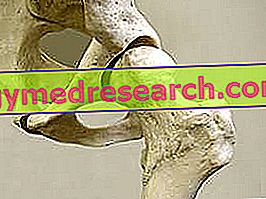Generality
The sphenoid, or sphenoid bone, is the uneven bone of the skull, located in front of the two temporal bones and below the frontal bone.

Comprised in the middle cranial fossa, the sphenoid is a bone morphologically similar to a butterfly, on which at least 6 characteristic elements are recognizable, which are: the sphenoidal body, the two major wings, the two minor wings and the two pterygoid processes.
The sphenoid is an important bone, because: it helps to form the lateral wall of the skull and the floor on which the brain rests; it is the seat of attachment for important muscles of mastication; forms the posterolateral walls of the eye sockets and the posterior walls of the nasal cavities; finally, through a series of holes and channels present on its surface, it is a place of passage for nerves and blood vessels of the head and neck.
What is the Sphenoid?
The sphenoid, or sphenoid bone, is one of the 8 bones of the so-called neurocranium (or cranial box ), ie the upper skeletal complex of the skull, within which the brain is enclosed.
Fundamental component of the so-called floor of the skull (or base of the skull ), the sphenoid is an uneven bone (so it is a unique element), with a very complex shape.
Short anatomical revision of the Skull
The skull of the human being can be divided into two main skeletal complexes: the aforementioned neurocranium and the splancnocranium .
Deputy to act as a container for the encephalon, the neurocranium is a structure composed not only of the sphenoid, but also of 7 other bone elements, which are: the frontal bone, the two temporal bones, the two parietal bones, the occipital bone and the ethmoid bone.

Intended to give shape to the vault, instead, the splancnocranium is a structure made up of as many as 14 bones, which are: the two zygomatic bones, the two tear bones, the two nasal bones, the two palatine bones, the two lower nasal horns, the two maxillary bones, the vomer and the mandible.
Anatomy
The sphenoid is morphologically similar to a butterfly or a bat with extended wings.
Including in the ideal region of the skull known as middle cranial fossa, the sphenoid is composed of:
- A central portion called the sphenoid body or sphenoidal body ;
- Two small extensions, one for each antero-superior side of the body, called minor wings ;
- Two large extensions, one for each postero-inferior side of the body, identified with the name of major wings ;
- Two bone processes, one for each end of the lower edge of the sphenoid body, called pterygoid processes .
Position: Where is the Sphenoid?
The sphenoid takes place: about the middle of the floor of the skull (or base of the skull), in front of the two temporal bones and the so-called basilar part of the occipital bone, and under the frontal bone and the two parietal bones.

Sphenoid Parts
BODY OF THE SPHERE
Cubic in shape and substantially hollow inside, the body of the sphenoid is, of this unequal bone of the skull, its central portion.
From the anatomical point of view, the sphenoid body is particularly relevant:
- The upper surface, as it hosts the so-called sella turcica and the so-called chiasmatic groove .
The sella turcica is a depression similar to a saddle for horses, including an anterior part, called the tubercle of the saddle, a back part, called back of the saddle, and a central concave portion, known as pituitary fossa, whose task is to accommodate and protect the pituitary gland .
The chiasmatic groove, on the other hand, is the characteristic groove situated anterior to the tubercle of the Turkish saddle, within which the optic nerves intersect, generating the so-called optic chiasm .
- The lateral surface, because it constitutes, along with the major wings, the medial wall of the optical channel ; the optical channel is space within which the optic nerve ( II cranial nerve ) and the ophthalmic artery pass before reaching the eye .
- The front surface, as it helps to form the nasal cavities ; the nasal cavities are the spaces connected with the external openings of the nose (nostrils), through which the air destined to reach the lungs enters.
- The internal cavity, since it constitutes the so-called sphenoid sinuses ; covered by pharyngeal mucosa, the sphenoid sinuses serve, like the other paranasal sinuses, to: improve the perception of odors, amplify the sounds and the voice, make the skull less heavy and umifidica-heat-purify the inspired air.
deepening
The sella turcica is surrounded by the so-called anterior clinoid processes and posterior clinoid processes ; the anterior clinoid processes are related to the minor wings, while the posterior clinoid processes with the back of the sella turcica.
From the functional point of view, the anterior and posterior clinoid processes are the bony structures of the sphenoid deputy to engage the tentorium of the cerebellum, that is the portion of meninge dura mater that divides the brain from the cerebellum .
ALI MAGGIORI
The major wings of the sphenoid bone are the two bony projections that extend upwards, to the right and left of the posterior portion of the sphenoid body.
The major wings are anatomically important, because:
- They make a decisive contribution to forming the floor of the skull inside the region known as the middle cranial fossa;
- With their lateral surfaces, they form part of the lateral wall of the skull ;
- With their anterior surfaces, they constitute the postero-lateral wall of the two ocular orbits ;
- They are home to 3 holes: the so-called round hole, through which the maxillary nerve passes, the so-called oval hole, through which the mandibular nerve and the accessory meningeal artery run, and the spinous hole, through which the median meningeal vessels pass and the spinous nerve (a branch of the mandibular nerve).

It is also essential to point out that the larger wings, with the contribution of the lower wings and of the body, delimit a large opening, called the upper orbital fissure, which serves to pass through:
- The upper ophthalmic vein ;
- The ophthalmic nerve (branch of the trigeminal nerve or V cranial nerve ) and its branches;
- The abducent nerve ( VI cranial nerve );
- The oculomotor nerve ( III cranial nerve );
- The trochlear nerve ( IV cranial nerve ).
Did you know that ...
The floor of the skull is the bony area of the skull on which, in fact, the brain rests.
ALI MINORI
Flat and triangular in shape, the lesser wings of the sphenoid are the two bony projections that emerge, then grow upwards, one from the side and one from the left side of the anterior portion of the sphenoidal body. The lesser wings of the sphenoid, therefore, reside anteriorly to the greater wings.
Of the lesser wings of the sphenoid it is essential to highlight:
- Their participation, together with the lateral wall of the sphenoid body, to the generation of the aforementioned optical channel (transit site for the optic nerve and the ophthalmic artery;
- Their upper surfaces, as they mark the border between the anterior cranial fossa and the middle cranial fossa (within which, as reiterated on more than one occasion, the sphenoid resides);
- Their lower surfaces, because they participate in the lateral margin of the eye sockets and contribute to the realization of the already mentioned superior orbital fissure;
- Their contribution to the formation of anterior clinoid processes (see previous study on the sphenoid body), which still serve as the tentorium of the cerebellum.
PTERIGOID PROCESSES
The pterygoid processes of the sphenoid are two bony protrusions, which arise, developing downwards, one to the right and one to the left of the lower portion of the sphenoid body (the exact point of origin, for each pterygoid process, is at the junction of the sphenoid body and the ipsilateral major wing).
Each pterygoid process of the sphenoid consists of two parts, called lateral pterygoid plate and medial pterygoid plate :
- The lateral pterygoid plate is the outermost part of the pterygoid process and constitutes the site of origin of the lateral (or external) pterygoid muscle, one of the 4 masticatory muscles (NB: they are muscles that contribute to the movement of the jaw, during the action of chewing).
- The medial pterygoid plate, on the other hand, is the innermost part of the pterygoid process and acts as a coupling seat for the pharyngeal constrictor muscles and the palatal vein tensor, which are fundamental to swallowing ;
deepening
At the lower end of the medial pterygoid plate, a bone growth occurs, called the pterigoid hamulus, which serves to favor the sliding of the tendon associated with the tensor muscle of the palatal veil and to predispose the palate to swallowing.
On each pterygoid process, moreover, there are two channels: the pterygoid canal, through which the major petrous nerve, the deep petrous nerve, the so-called pterygoid canal artery and the so-called pterygoid canal vein, and the palatovaginal canal (or canal pharyngeal ), through which the pharyngeal nerve flows.
Borders and Reports
The sphenoid is in contact with as many as 12 bones of the skull ; to be precise, the sphenoid bone borders with 4 unequal cranial bones - which are the frontal, the ethmoid, the vomer and the occipital - and 8 even cranial bones - which are the two zygomatic, the two parietal, the two thunderstorms and the two palatine.
Joints

To connect the sphenoid to the 12 bones of the skull that are adjacent to it are joints of a fibrous type (therefore not very mobile), which the experts identify with the generic name of cranial sutures .
Among the various fibrous joints that join the sphenoid to the neighboring cranial bones, they deserve a special mention:
- The spheno-frontal suture, which joins the sphenoid to the frontal bone;
- The spheno-parietal suture, which joins the sphenoid to the parietal bone (even cranial bone);
- The spheno-squamous suture, which connects the sphenoid to the temporal bone (even cranial bone);
- The spheno-occipital suture, which joins the sphenoid to the occipital bone (NB: this joint "disappears" around the age of 25, as the sphenoid and occipital bone, where they confine, merge with each other).
Function
Experts recognize the sphenoid at least 5 functions, which are:
- Contribute to the base and sides of the skull ;
- Constitute the floor and the posterolateral walls of the eye sockets ;
- Contribute to the generation of the posterior walls of the nasal cavities ;
- Hook a series of fundamental muscles to the chewing process ;
- Through the various holes and channels present on the bone surface, allow the passage of blood vessels and nerves belonging to the anatomical compartments of the head and neck.
Clinical Use
The sphenoid is a very important bone in the surgical management of pituitary tumors (eg: pituitary adenoma ), as its sphenoid sinuses make it possible to introduce the instruments necessary for treatment to the organ affected by the pathology.
An optimal alternative to the more invasive craniotomy, the surgical technique that exploits the cavities present in the body of the sphenoid is called trans-sphenoidal endoscopic surgery .



